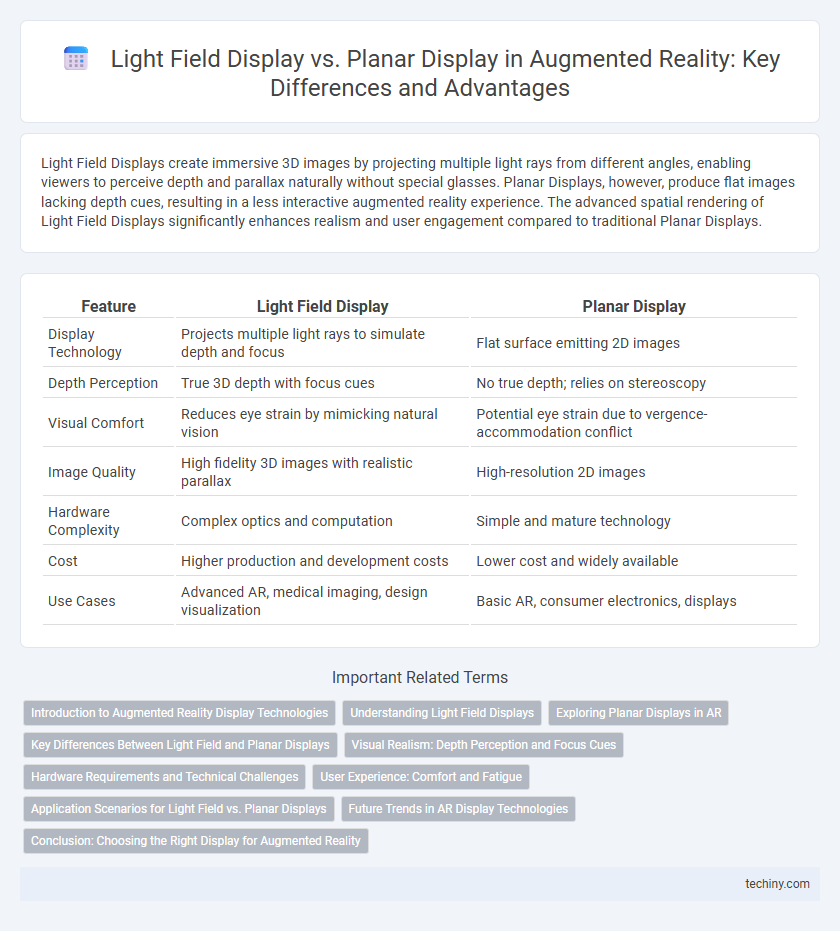Light Field Displays create immersive 3D images by projecting multiple light rays from different angles, enabling viewers to perceive depth and parallax naturally without special glasses. Planar Displays, however, produce flat images lacking depth cues, resulting in a less interactive augmented reality experience. The advanced spatial rendering of Light Field Displays significantly enhances realism and user engagement compared to traditional Planar Displays.
Table of Comparison
| Feature | Light Field Display | Planar Display |
|---|---|---|
| Display Technology | Projects multiple light rays to simulate depth and focus | Flat surface emitting 2D images |
| Depth Perception | True 3D depth with focus cues | No true depth; relies on stereoscopy |
| Visual Comfort | Reduces eye strain by mimicking natural vision | Potential eye strain due to vergence-accommodation conflict |
| Image Quality | High fidelity 3D images with realistic parallax | High-resolution 2D images |
| Hardware Complexity | Complex optics and computation | Simple and mature technology |
| Cost | Higher production and development costs | Lower cost and widely available |
| Use Cases | Advanced AR, medical imaging, design visualization | Basic AR, consumer electronics, displays |
Introduction to Augmented Reality Display Technologies
Light field displays create immersive augmented reality experiences by projecting light rays that mimic natural viewing angles, enabling true 3D perception without the need for glasses. Planar displays, by contrast, rely on flat screens that overlay digital content onto the real world but lack depth cues and realistic parallax effects. These differences significantly impact user engagement, spatial awareness, and the overall effectiveness of AR applications across gaming, design, and medical fields.
Understanding Light Field Displays
Light field displays capture and reproduce light rays' direction and intensity, enabling true 3D visualization without glasses, unlike planar displays that present flat images. This advanced technology enhances depth perception and realism by simulating how light interacts with objects in space. Light field displays are crucial for augmented reality, offering immersive experiences by accurately rendering virtual elements alongside real-world environments.
Exploring Planar Displays in AR
Planar displays in augmented reality offer a lightweight and cost-effective alternative to light field displays, relying on flat screens that project images directly onto the retina or through waveguides. These displays deliver high resolution and rich color fidelity, making them ideal for applications requiring sharp visuals and compact form factors. Emerging planar display technologies continue to enhance user comfort and immersion by reducing optical distortions and enabling wider fields of view.
Key Differences Between Light Field and Planar Displays
Light field displays project multiple light rays at varying angles, creating a true 3D image with depth cues like parallax and focus, while planar displays present flat 2D images with no depth perception. Light field technology enhances user immersion by allowing natural eye accommodation, reducing visual fatigue compared to planar screens. This fundamental difference makes light field displays ideal for applications requiring realistic spatial visualization, such as medical imaging and augmented reality, whereas planar displays remain common for standard viewing tasks.
Visual Realism: Depth Perception and Focus Cues
Light field displays provide superior visual realism by rendering multiple perspectives and depth cues simultaneously, enabling accurate focus and accommodation for the human eye. Planar displays lack true depth perception, presenting images on a flat surface that can cause visual discomfort and reduced immersion. Enhanced depth cues in light field technology significantly improve user experience in augmented reality by mimicking natural vision more effectively.
Hardware Requirements and Technical Challenges
Light Field Displays require advanced multi-layered optical hardware and high-resolution light engines to project depth-varying light rays, demanding substantial computational power and precise calibration. Planar Displays utilize conventional flat panels with simpler hardware, but lack true depth representation, leading to limited immersion. The technical challenge for Light Field technology lies in managing large data throughput and optical complexity, whereas Planar Displays face constraints in delivering realistic 3D effects without external aids.
User Experience: Comfort and Fatigue
Light Field Displays deliver a more natural and immersive viewing experience by accurately simulating depth cues, significantly reducing eye strain and visual fatigue compared to traditional Planar Displays. Users benefit from enhanced spatial perception and focus comfort, which is crucial for prolonged use in augmented reality environments. Unlike Planar Displays that often cause vergence-accommodation conflicts, Light Field Displays maintain ergonomic visual alignment, promoting sustained comfort and decreasing cognitive load.
Application Scenarios for Light Field vs. Planar Displays
Light Field displays enable realistic depth perception and parallax effects, making them ideal for medical imaging, advanced design visualization, and immersive training simulations where spatial accuracy is critical. Planar displays remain suitable for conventional applications such as video playback, standard gaming, and general-purpose computing due to their lower cost and simpler technology. The ability of Light Field technology to render multiple focal planes addresses limitations in eye strain and realism that planar displays typically exhibit.
Future Trends in AR Display Technologies
Light field displays in augmented reality offer superior depth perception and realistic visual experiences by projecting multiple viewpoints, addressing limitations found in planar displays that rely on flat, single-perspective screens. Future trends in AR display technologies emphasize enhancing light field display resolution, reducing hardware bulk, and integrating AI-driven eye tracking for adaptive focus and interactive experiences. These advancements aim to overcome current challenges in visual comfort and immersion, positioning light field displays as the forefront innovation for next-generation augmented reality applications.
Conclusion: Choosing the Right Display for Augmented Reality
Light Field Displays provide superior depth perception and realistic holographic visuals by projecting multiple light rays per pixel, making them ideal for immersive augmented reality experiences requiring precise spatial awareness. Planar Displays, while more cost-effective and compatible with existing hardware, offer limited depth cues, suitable for simpler AR applications with constrained budgets. Selecting the right display hinges on balancing visual fidelity, device complexity, and application-specific requirements to optimize user engagement and functionality in augmented reality environments.
Light Field Display vs Planar Display Infographic

 techiny.com
techiny.com